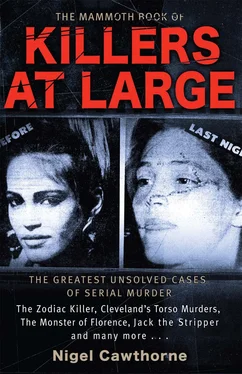The perpetrator was five foot seven inches tall and thin. He had sandy blond hair with a reddish tint and designer stubble. After a month, his killing spree stopped, leading the police to believe that he was in jail for some other offence. Then in 1993 he started killing again in Texas, where he shot three more women using the same .22 automatic pistol.
Kansas City’s Independence Avenue Killer
A serial killer has been killing women from Kansas City’s red light district around Independence Avenue and dumping them in the Missouri River, earning him the name the “Independence Avenue Killer” or the “Missouri River Killer”.
The hunt began on 10 October 1996 when the body of 21-year-old Christy Fugate, aged 21, was pulled from the waters of the Missouri River near Dover in Lafayette County, Missouri, some 50 miles downriver from Kansas City. She had gone missing the previous month. Since then, nine more bodies of Kansas City women have been found downstream.
On 29 March 1997, the body of Sherri Livingston was spotted in the river near where Christy Fugate had been found. She had been reporting missing in February. Three weeks later, on 22 April 1997, Connie Wallace-Byas’s body was recovered. She had been reported missing the previous October. The following day, the body of Linda Custer was found near Dover. She had gone missing in February. Two weeks after that, on 7 May, the body of Chandra Helsel was found 80 miles further on near Booneville. She had been missing since 17 April. On 31 July 1997, Wilmalee Manning’s body was recovered from the river. Then on 31 August, Lana Alvarez’s body was found. In March 1998, Maria Woods’ body was found in the river. On 2 April 1998, the mutilated body of Tammy Smith was found in the river near Sibly, just 25 miles downstream from Kansas City.
All the victims were thought to be prostitutes working in the Independence Avenue area of Kansas City, Missouri. For once the police were quick to admit that a serial killer was at work as all the women were of approximately the same height and weight. They issued a warning that a serial killer was on the prowl, but few heeded it.
Four more missing women are thought to have been the victims of the mysterious Missouri River Killer. They are 18-year-old Jennifer Conroy, who was last seen on 14 December 1993; 41-year-old Jamie Pankey, last seen 30 July 1996; 33-year-old Connie Williams, last seen 16 October 1996; and 20-year-old Cheresa Lordi, last seen 14 February 1997.
At the end of September 1997, 28-year-old Chuck Blatz, a student at the University of Wisconsin’s Platteville campus, travelled from his home in Kiel, Wisconsin, to La Crosse for the annual Oktoberfest. He was five foot ten inches tall, weighed 130 pounds and had recently been honourably discharged from the military. On the night of Saturday, 27 September 1997 he was at Sneakers, a popular downtown bar and left some time after midnight. Five days later his body was pulled from the Mississippi River, that flows through La Crosse, by a fisherman. One of his socks was missing along with one of his black sneakers. Blatz was known to be a strong swimmer and a keen scuba diver. He was an unlikely victim of drowning.
Two days after Blatz’s body was found, 19-year-old Anthony Skifton disappeared. Skifton was last seen alive at 2.30 a.m. on 5 October 1997, when he left a party carrying a case of beer. Five days later he was found floating in Swift Creek, not far from a gay cruising area. His bladder was empty and his flies unzipped. This led the authorities to believe that he had been urinating in the river when he slipped and fell into the freezing waters. However, Skifton was not a good drinker. He had a reputation for getting drunk and passing out early. Everyone would pounce on him with magic markers and he would wake up with writing all over his face. When his body was recovered the case of beer was missing. His death could easily have been accidental—had it not fitted into a disturbing pattern.
On 22 February 1998 Nathan Kapfer, a 20-year-old baseball player who was attending nearby Viterbo College on an academic scholarship, went missing. At 5 foot 10 inches and weighing 150 pounds, he bore a striking resemblance to the other two missing boys. But the night he went missing, he turned up at a downtown pub called Brother’s Bar after having DJ’d at a local party. He was drunk and the bartender refused to serve him. When the bouncer was called to escort him out of the bar, Kapfer cursed. The police were called and he was arrested. At the police station he was given citations for underage drinking, disorderly conduct, possessing false identification and being in a bar under the age of 21. Then, at around 2 a.m., he was released. Soon after, his hat, wallet and the four tickets he had been given were found laid out neatly on the deck of a riverboat gift shop. His body was fished out of the water downstream six weeks later. A post mortem revealed that his blood alcohol level was 0.22 percent—above 0.15 percent you are considered drunk when driving. According to the authorities the evidence suggests that Kapfer had committed suicide. His death could have been an accident, or he could have been pushed.
Then on 10 April 1999 Jeffery Geesey went missing. A 20-year-old student at the University of Wisconsin-La Crosse, he did not return to his dorm that night. He was last seen in a bar on Third Street. Forty-one days later, on 22 May his body was found in the Big Muddy by two fishermen. The medical examiner classified the manner of death as “undetermined”. But unofficially, the police considered it a suicide as there were four shallow self-inflicted scars on his arms. But Geesey’s father said that, after an overnight stay in hospital visit, a psychological evaluation had determined. that when Jeff cut himself, he was upset—but not suicidal.
There was other evidence to suggest that Jeff Geesey did not kill himself. The bloodhound used to search for him hit on a scent that indicates Geesey experienced trauma in several locations. At the Niedbalski Bridge, around a mile from Third Street, the dog found Geesey’s blood.
“She was licking the pavement,” said Penny Bell, the dog’s handler. “But there was no forensics follow-up.”
La Crosse police chief Ed Kondracki was sceptical.
“Things she said those dogs could do, dogs can’t do,” he said.
Like the other young men the river had claimed, Jeff Geesey was young and fit—6 foot 2 inches tall and 200 pounds. And he was a little drunk when he went missing. However, for four strapping young men to drown in the river in the space of two years seemed like too much of a coincidence. The theory circulated that a serial killer was at work.
The police, however, dismissed it. The deaths were classified as “exceptional clearance”, meaning that they were not witnessed and there was no evidence to suggest that a crime had been committed. Consequently, they must have been accidents or self-inflicted and the trail went cold.
Then on the night of 9 April 2004, Jared Dion and his brother Adam went out with their friends. It was a cold night, in the low 40s, and a chill wind blew through La Crosse. But it was a Friday night and the students from the University of Wisconsin went out drinking. Jared Dion was a 21-year-old sophomore, 5 foot 9 inches tall and weighing 172 pounds. And he was fit. An outstanding athlete at high school, he was a member of the college wrestling team. That night he was drunk, but no more drunk than the other college revellers and few took any notice when he staggered out of the bar. Five days later, his body was fished out of the Mississippi.
Authorities said his death an accident. The post mortem found that he had drowned and his blood-alcohol level was a massive 0.28 percent, nearly twice the level at which the law considers a person to be intoxicated. The police maintain that he was drunk, wandered too close to the river and fell in.
Читать дальше











